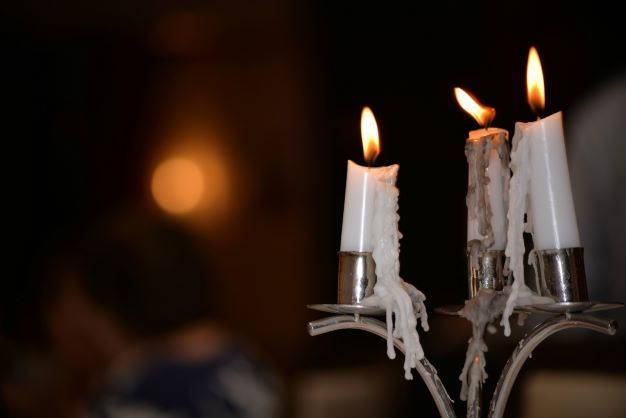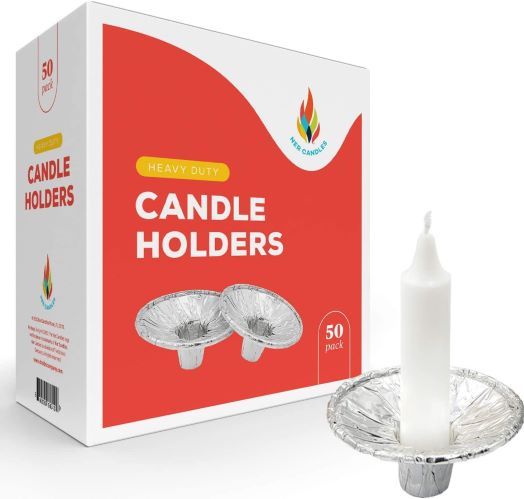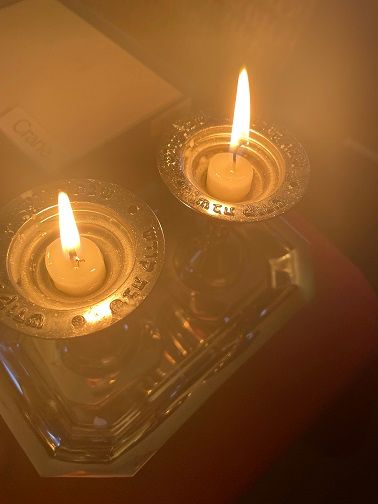My Inner Martha Stewart

We'll gather tonight to welcome Shabbat. Here are the coordinates for our meeting:
Zoom
Meeting ID: 963 5113 1550
Password: 1989
Phone: +1 312 626 6799
(To unsubscribe from the email, click the link at the bottom of it.)
Here we go
Usually, lighting Shabbat candles results in wax dripping onto the candlesticks and, eventually, you’ll want to remove that wax. So, I’m going to release my inner Martha Stewart and share with you some tips and tricks I’ve learned.
Just say no
The easiest way to keep your candlesticks clean is to not drip wax on them in the first place and there’s a variety of techniques to accomplish this. Perhaps the easiest and least expensive way to do this is to take a four-inch square of aluminum foil and place it flat over the socket for the candle. Then, push the candle and foil into the socket. You might need to bend the foil into the right shape to catch the dripping wax, but, voilà, you’re set.

A step up from this homemade solution is to use pre-made foil drip catchers. Available in boxes of 50 for about $5.00, these foil drip guards are both reusable and disposable.
I used these until, while I was still living in Madison, a dear friend saw my box of pre-made foil drip catchers and gifted me a pair of beautiful, permanent, metal drip catchers. You still have to get the candle stub out of the socket of the drip catcher and clean off the wax, but it’s a much more manageable chore than cleaning the candlestick. And mine are much prettier than aluminum foil.

The takeaway? An ounce of prevention is worth a pound of cure.
But what if you don’t want to use drip catchers as they interrupt the pretty lines of your candlesticks? Then, it’s on you to keep them clean. Fortunately, there are general and specific techniques you can use to keep your candlesticks spotless.
Your friend, the credit card
Both the simplest and most arduous way to remove wax from candlesticks is with the edge of a credit card. The card is hard enough to chip away the wax but not so hard as to scratch the candlestick. To make the chipping away process a little easier, before you use your candlesticks, you might want to try spraying your candlestick with non-stick cooking spray like Pam. The protective sheen of the spray makes it easier to chip off the wax.
Physics
Another way to make chipping the wax off easier is to use the fact that the wax isn’t as dense as the candlestick. The wax and the candlestick will change temperature at a different rate and the wax should pop off the candlestick. You can use both cold and heat to easily remove the dripped wax. Of the two choices, I prefer using cold. Here’s how it goes: Take your candlesticks and put them in a plastic bag to protect them. Then, put the candlesticks in your freezer for 45 minutes. When your timer chimes, take them out of the freezer, grab your credit card and get chipping.
The problem with using heat is the risk that the wax may get too soft and instead of chipping off, the wax smears and is even harder to get off. But if you want to try, here are my recommendations.
Take a hairdryer and set it on high heat. Focus it on a section of the candlestick and warm the wax until it chips off with your credit card. Heat the wax too long and it will smear. Told you so.
Another way to try using heat is in your kitchen sink, although this incurs an additional risk. Run your water until it’s as hot as it gets, close the drain, place your candlesticks in the sink, and cover them with the hot water. Check on the candlesticks after ten minutes to see if the wax will flake off with the, you guessed it, edge of your credit card. Just be very careful not to let the wax go down the drain as that’s a sure way to cause a clog. And if you use glass or crystal candlesticks, the hot water might make them crack or altogether break. You’ve been warned.
Chemistry
Finally, there are a variety of chemical techniques that depend on what your candlesticks are made of.
Glass and Crystal
Use glycerin or denatured alcohol and a paper towel.
Silver
Use olive oil on a soft cloth
Stainless steel
Use rubbing alcohol and a soft cloth
Brass or Copper
Make a paste by mixing 1 teaspoon of salt, 1/2 cup of vinegar, add flour to make a paste. Rub it on and leave 10 minutes. Chip away and then rinse with warm water. Do not use alcohol on brass or copper as it will remove the protective lacquer covering it.
One of these ways is bound to work for you.
I have complicated feelings about cleaning Shabbos candlesticks. When my family used the crystal candlesticks we were gifted as a wedding present, and we were foolish enough not to use a drip catcher, cleaning those candlesticks was a necessary chore that required a delicate touch and a razor blade. (I wasn't so smart then.) It put me off beautiful, fragile candlesticks after I eventually / inevitably broke them. Today, I use an inexpensive, nickel-plated pair of candlesticks with those beautiful drip catchers my dear friend gifted me. Cleaning them isn’t much of a chore and, besides, I like letting the wax build up a bit. It makes them look well used. I like that.
All my love,
brian.
briandjohnson@gmail.com